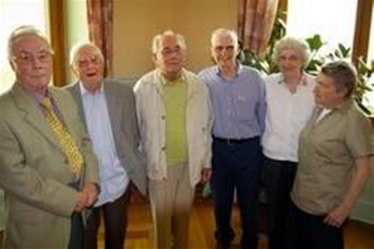© Dernières Nouvelles D'alsace, Vendredi 05 Mai 2006.
Tous droits de reproduction réservés
L. Mallory, sole survivor of an RCAF bomber
 |
From L. to R. René Lutringer, who lived in the house in rue Gallieni, the second refuge for the gunner, Gustave Laborie, who particip/ated in the rescue, Roger Ringenbach, then employed at the farm on Freundstein and the one who, being most near to the crash, had dug temporary graves for the dead crew members (these men now lie at the Canadian cemetery in Toul) Lorne Mallory, his wife Constance, and Colette Gasser, who lived in the house in rue Joffre, first hiding place of the gunner. |
In the blue shirt, at the side of his wife Constance, Lorne Mallory meets with those who saved his life at the end of 1944. (Photo DNA)
At 19 years of age, Lorne Mallory, a young Canadian of the Royal
Canadian Air Force, based in England, was rescued by several
inhabitants of Willer-sur-Thur after his bomber, in which he was a
machine gunner, crashed above the farm of Freundstein.
He never came back to Alsace, nor Europe.
Lorne Mallory, of a quiet,
unassuming nature, met again yesterday afternoon the various
individuals involved in the young Canadian aviator's escape, taken
during the torments of war. Lorne occupied the position of mid-upper
gunner in Halifax MZ-807, which was most likely hit by flak while
returning from its mission over Germany during the night of 3-4
December 1944. The bomber, which had lost its right-side motor,
impacted the peak of an Alsatian hill, some hundred metres above the
location of the farm-auberge of Freundstein, near Willer-sur-Thur.
His six companions perished in the crash. Lorne, suffering from burns
to his hands and face, was the only one to escape from the crash. He
spent a day and part of one night, alone, up there, before the people
of Willer, including M. Dibling, were able to retrieve him.
Willer-sur-
Thur at this date found itself still under occupation by the Germans,
and at the front lines of combat for the liberation. It was necessary, therefore, to hide and care for the Canadian aviator as discreetly as
possible. It was at the domicile of M. Dibling where he found refuge
and cover. The medical care sisters (nuns) of the village came, with
every discretion, to lavish on him the care that his condition required.
Warm meeting again under the auspices of the AAHAA
But, with the house Dibling being in the line of fire of the liberation
armies and in the field of fire of mortars, it was decided to transfer the
brave aviator for several days to the home of the Laborie family, in rue
Galliéni. Augustin Laborie, while meeting again yesterday afternoon
the Canadian aviator, had tears in his eyes.
It was a warm meeting arranged under the auspices of the AAHAA, l'Association des amis de
l'histoire de l'aviation en Alsace (Association of Friends of Aviation
History in Alsace), overseen by Jean-Marie Deharvengt and by the
mayor of Willer, Alain Delestan. It was, moreover, at the town hall
where the very moving meeting was held yesterday afternoon, as a
prelude to the ceremonies of this weekend.
Among the invited guests, Lorne Mallory could meet again Roger
Ringenbach, of Niederbruck, who recounted to him how he had buried
clandestinely the bodies of the six victims of the Halifax , together with
René Luttringer.
To finish the story of Lorne Mallory, it's necessary to know that he
stayed hidden for almost a week, until the liberation of Willer, on 9
December. As soon as practicable, the wounded aviator was take in
charge by the (military) medical services, and transported to the
American hospital in Neuilly, before his return, in February 1945, to
England and a little later to Port Perry, the city in Ontario, close to
Toronto, from which he had started his adventure.
A small story, perhaps, among so many others, in the swirl of the
history of the last great conflict. And while he's a man of few words,
Lorne Mallory is pleased that all "these brave lads" have finally been
recognized.
As of next week, he will go back to Canada, after the people of Willer-on-Thur show their recognition to him. And of course, no one knows more about this tragic episode of the war than Dr. Seither, first president of the AAHAA, who started to research and seek witnesses to this event in 1976.
A. Hartmann